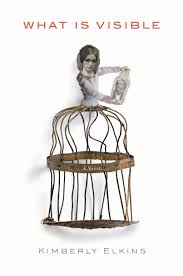
2014 was a particularly strong year for historical fiction. However, What Is Visible stood out by far. You can read about the other commended novels for the Langum Prize for American Historical Fiction here.
What Is Visible by Kimberly Elkins lyrically revives a significant and intriguing figure in the history of disability. Laura Bridgman (d. 1889) was a celebrity in her lifetime though overshadowed by Helen Keller now. Stripped of sight, hearing, taste and smell by scarlet fever in her childhood, Bridgman served as a poster child for the Perkins School for the Blind and various intellectual causes such as phrenology and anti-Calvinism.
Laura's desperate need to command attention and to please others conflicts with her desire for a private life distinct from any larger cause. Through meticulous archival and imaginative labour, Elkins provides Bridgman with an inner life that offers a daring and convincing account of a woman who observes and communicates only through touch. As the author articulates in the appendix, the novel concerns “what might have happened as well” rather than “what might have happened instead.” Following this method, Elkins attends to Bridgman's parameters for pleasure, longing, deprivation and defiance with a narrative voice that evokes sympathy without sentimentality.
Most of the novel gathers snugly around Bridgman's life and perceptions, interspersed with the perspectives of those around her. In addition to the host of passing contemporary notorieties, such as Charles Dickens, who visit and comment upon her, Bridgman's life intersects with prominent figures in more sustained ways. These include her doctor Samuel Gridley Howe, the poet Julia Ward Howe, and even the abolitionist John Brown.
Both for its historical dexterity and its compelling narrative voice, What Is Visible is strongly deserving of the prize.
What Is Visible by Kimberly Elkins lyrically revives a significant and intriguing figure in the history of disability. Laura Bridgman (d. 1889) was a celebrity in her lifetime though overshadowed by Helen Keller now. Stripped of sight, hearing, taste and smell by scarlet fever in her childhood, Bridgman served as a poster child for the Perkins School for the Blind and various intellectual causes such as phrenology and anti-Calvinism.
Laura's desperate need to command attention and to please others conflicts with her desire for a private life distinct from any larger cause. Through meticulous archival and imaginative labour, Elkins provides Bridgman with an inner life that offers a daring and convincing account of a woman who observes and communicates only through touch. As the author articulates in the appendix, the novel concerns “what might have happened as well” rather than “what might have happened instead.” Following this method, Elkins attends to Bridgman's parameters for pleasure, longing, deprivation and defiance with a narrative voice that evokes sympathy without sentimentality.
Most of the novel gathers snugly around Bridgman's life and perceptions, interspersed with the perspectives of those around her. In addition to the host of passing contemporary notorieties, such as Charles Dickens, who visit and comment upon her, Bridgman's life intersects with prominent figures in more sustained ways. These include her doctor Samuel Gridley Howe, the poet Julia Ward Howe, and even the abolitionist John Brown.
Both for its historical dexterity and its compelling narrative voice, What Is Visible is strongly deserving of the prize.
 RSS Feed
RSS Feed
